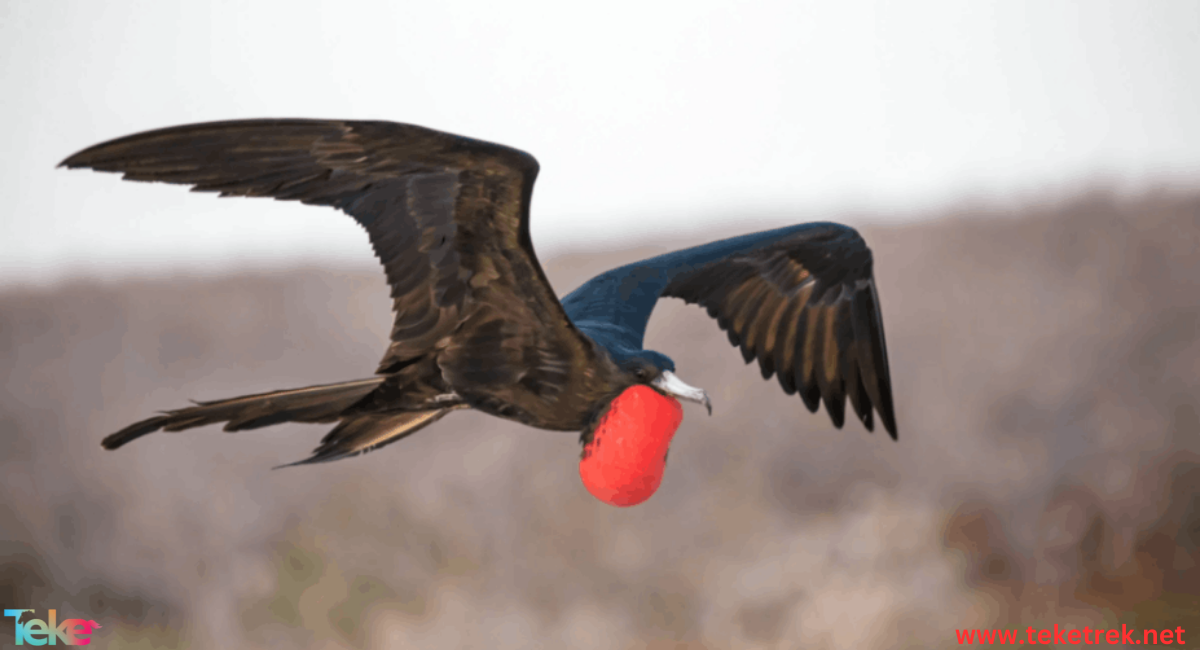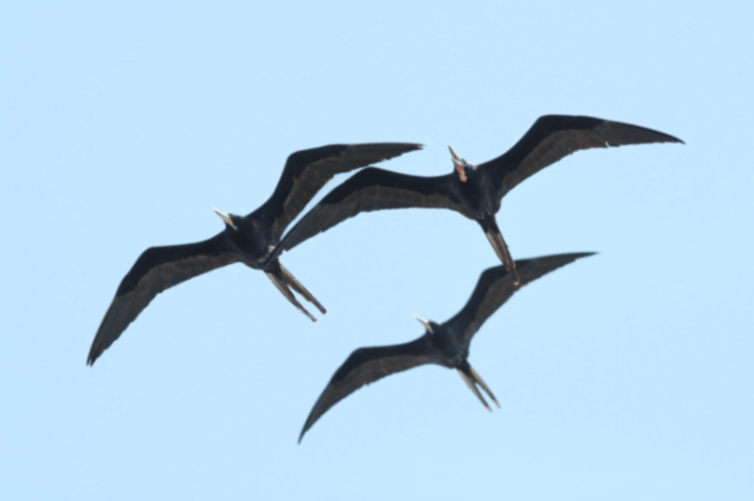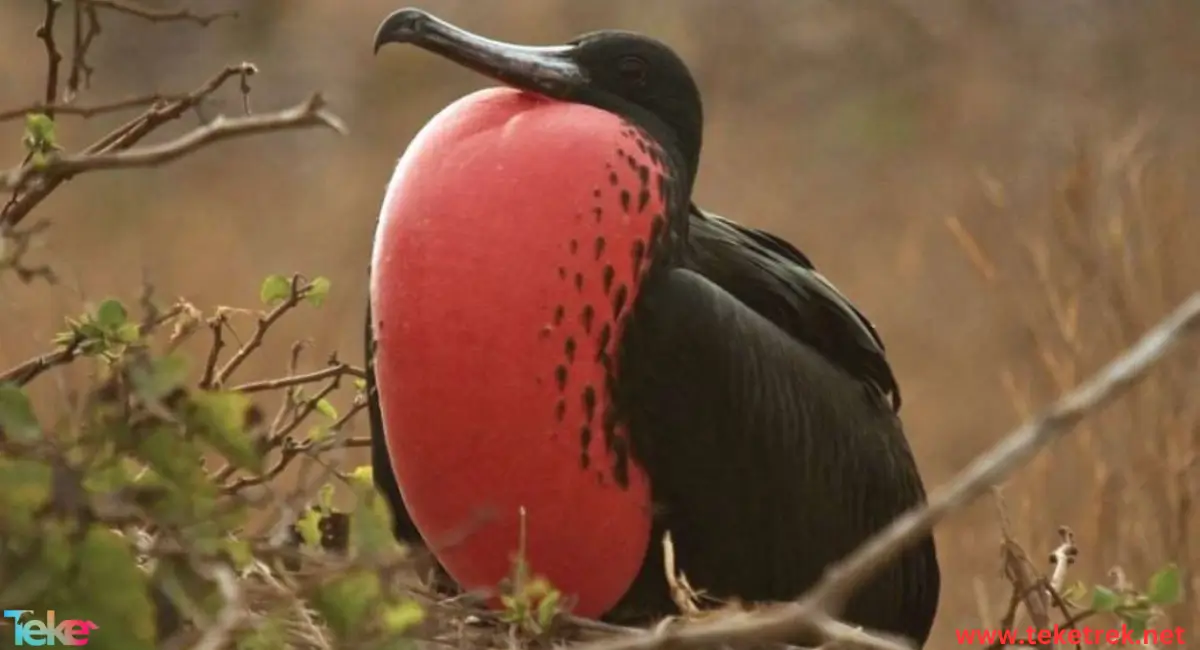The frigate bird is a sky pirate that flies high without fluttering in marine areas. Below we review on TekeTrek more details about it, how it lives, feeds, and reproduces, and we list the most notable facts that characterize the frigatebird.
About the frigate bird
The frigate bird is an animal belonging to the family of seabirds, kingdom Animalia, domain Eukaryotes, order Suliformes, family Fregatidae, genus Fregata.
- Species of one genus are classified as Fregata.
- They have black plumage, long, deeply forked tails and long, hooked beaks.
- Females have white bellies, while the male has a red circular sac, which he inflates like a balloon during mating to attract females.
- It has long, pointed wings up to 2.3 meters long.
- The frigatebird can fly for several weeks in the wind, searching for food, and roost at night in trees or cliffs.
- It has long, slender angular wings and flies easily alone or with groups of birds.

Naming the frigate
The name of the frigate bird was changed to Suliformes in 2010.
The family name Fregatidae was retained until 1994 and was cited in 1867 by the French naturalists Côme-Damien Degland and Zéphirin Gerbe, based on Article 40(b) of the International Code of Zoological Nomenclature, replacing the name Tachypetidae, which was coined by Johann Friedrich von in 1840. Considering that the names The genus Atagen and Tachypetes were synonymous with Fregata before 1961, so the family and genus names have been aligned.
Food at the frigate
The frigate is a carnivorous animal that feeds mainly on fish and squid. It:
- It catches prey when pursued by large predators such as tuna.
- The frigate also steals food from other sea creature.
Frigate habitats
The frigatebird is found over tropical oceans along the coast of the southern United States, Mexico, and the Caribbean, where it stays near the water.
- The frigate flies in the afternoon when the winds and temperatures are strong.
- Birds nest in colonies, building a rough nest in low trees or on the ground on remote islands.
- Their range coincides with two primary factors: the availability of food and the trade winds, which provide gusty conditions that make it easier for them to fly.
- Frigatebirds are widespread in temperate regions, while adults are sedentary near the islands where they breed.
- But the males have been recorded to disperse over long distances after leaving the breeding colony. The great one moved from the island of Europe in the Mozambique Channel to the Maldives, a distance of 4,400 kilometers, and the magnificent one flew 1,400 kilometers from French Guiana to Trinidad.
Reproduction by frigatebirds
The frigate is an animal that reproduces by eggs, as it lays only one egg every breeding season, and reproduces once every two years.
- The frigate bird’s reproductive period is long, with males and females incubating eggs for 56 days.
- After hatching, the chicks remain in the nest until they are 167 days old.
- The mother continues to feed the chicks until they are one year old.


Behavior and habits of the frigate
The frigate bird finds ways to protect itself from overheating by being exposed to full sunlight in the nest.
- They move their feathers to raise them away from the skin and improve air circulation and extend and raise their wings to expose the hot undersurface to the air and lose heat by evaporation and convection.
- They place their heads in the shadow of their wings, and the males flap their circular pouches.
- The frigatebird soars high on heat and uses the heat to glide.
Interesting facts about the frigate
Among the most prominent facts about the frigate bird:
- The frigatebird is the only seabird in which the male and female are clearly different.
- It spends most of its life flying on the ocean, and rarely lands on water even though its feet are webbed, as it does not have waterproof feathers.
- The oldest frigate bird was 19 years and 9 months old when it was recovered and released in the Lesser Antilles during a scientific study.
- English sailors called the Caribbean frigate the man-of-war because it hunted other birds and extracted food from them, and William Dampier used it in his novel A New Voyage Around the World in 1697.
Fossil record of frigates
The Eocene frigatebird genus Limnofregata contains birds whose fossil remains were recovered from prehistoric freshwater environments, unlike other modern seabirds.
- Their beak was short and less hooked, their legs were longer, and their nostrils were longer, like slits.
- Three types of fossil deposits have been described in the western United States:
- Two of them are L. azygosternon and L. azygosternon. hasegawai from the Green River Formation (48-52 million years ago).
- The third is —L, Hutchisonian of the Wasatch Formation (between 53 and 55 million years old).
- Pleistocene and Holocene fossil material from Ascension Island and St. Helena Island, both located in the South Atlantic Ocean, has been recovered from various Pacific islands.
- A phylogenetic study of the frigate bird’s skeleton also indicated that it formed a clade containing Limnofregata.
- It contains 15 cervical vertebrae, unlike most Ciconiiformes, Suliformes, and Pelecaniformes birds, which contain 17 vertebrae.
- The age of Limnofregata also indicates that these lineages separated in the Eocene.


FAQ
Among the most common questions about the frigate bird:
- How do frigates reproduce?
The frigate reproduces by laying eggs. The female lays one egg every two years. It is characterized by a long incubation period of up to 56 days.
- How does the frigate bird feed?
The frigate bird feeds on fish and squid.
- Is the frigatebird a carnivore or an herbivore?
The frigate is a carnivorous animal that feeds on fish and squid.
- Where does the frigate live?
The frigatebird is a marine animal found along the coast of the southern United States, Mexico, and the Caribbean.
- How does the frigate settle?
The frigate bird nests in colonies, building a rough nest on remote islands in low trees or on the ground.
- Why is a frigate called a man of war?
The frigate bird is called the man of war because it chases other birds and takes food from them.
- What is unique about the frigate bird?
Frigate birds are unique for their impressive wingspan and ability to stay in the air for long periods of time.
- Why do frigate birds sleep while flying?
Frigate birds sleep while flying to avoid predators and conserve energy.
- How long can a frigate bird fly?
Frigate birds can fly for weeks at a time without landing.


Briefly, the frigatebird is a carnivorous, oviparous seabird known as the man-of-war famous for its long tail.






